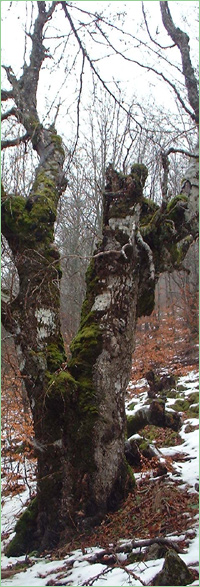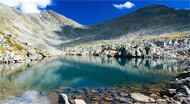Emen (Unique identification code in the register: BG0000216)
Category: PZ under the Habitat Directive
Area: 490.99 hectares Location:
1.
District: Veliko Tarnovo, Municipality: Pavlikeni, Locality: Mihaltsi, Musina, Vishovgrad
2.
District: Veliko Tarnovo, Municipality: Veliko Tarnovo, Locality: Emen
Falls in the territory of the following Regional Inspectorates of Environment and Water (RIEW):
Veliko Tarnovo - ul."N.Gabrovski" 68
Ordinance for announcement:
Ordinance No.РД-687 from 25.08.2020
2-2-216-687-2020
Record for protected zone (link):

Aims of the declaration:
1. Protection and maintenance of natural habitats types under item 2.1, habitats referred to item 2.2. species, their populations and distribution within the area to achieve and maintain their favorable conservation status in Continental biogeographical region;
2. Improving the structure and functions of natural habitats with codes 6110*, 6240*, 7220*, 91H0*, 91М0 and 91Z0;
3. Improvement of habitats of species Triturus karelinii), Testudo hermanni, Testudo graeca and Emys orbicularis;
4. If necessary, improvement of the condition or restoration of types of natural habitats refered in item 2.1, habitats of the species refered in item 2.2 and their populations.
Objects of protection (species or habitats):
1. Article 6, paragraph 1, section 1 from Biological Diversity Act: - 3260 Water courses of plain to montane levels with the Ranunculion fluitantis and Callitricho-Batrachion vegetation
– 6110 * Rupicolous calcareous or basophilic grasslands of the Alysso-Sedion albi;
– 6210 Semi-natural dry grasslands and scrubland facies on calcareous substrates ;
– 6240 * Sub-Pannonic steppic grasslands;
– 7220 * Petrifying springs with tufa formation (Cratoneurion);
– 8210 Calcareous rocky slopes with chasmophytic vegetation;
– 8310 Caves not open to the public;
– 91E0 * Alluvial forests with Alnus glutinosa and Fraxinus excelsior (Alno-Padion, Alnion incanae, Salicion albae);
– 91H0 * Pannonian woods with Quercus pubescens;
– 91М0 Pannonian-Balkanic turkey oak-sessile oak forests;
– 91Z0 Moesian silver lime woods;
2. Article 6, paragraph 1, section 2 from Biological Diversity Act: 2.2.1. Mammals – Rhinolophus hipposideros, Rhinolophus ferrumequinum, Rhinolophus euryale, Myotis blythii, Miniopterus schreibersii, Myotis capaccinii, Myotis emarginatus, Myotis myotis, Lutra lutra;
Current prohibitions and regimes:
1. It is prohibited to make a fire, improvements, electrification, conduct of business and sports activities in the caves and caves' entrances, as well as to break, damage, to collect or to remove of rock and cave formations, and also to divide the cave's entrance or its individual galleries in a way that prevents passing of species subject to protection under item 2.2.1;
2. 'It is prohibited conducting speleological research during the breeding season of bats - from March 1 to June 30;
3. It is prohibited the prospecting for minerals (construction and stone materials), creating new and expanding concession areas for extraction of minerals (construction and stone materials) in the territories occupied by the natural habitats under item 2.1; prohibition does not apply in cases where the date of publication of the order in the "Official Gazette" has started a procedure for granting permits for prospecting and / or exploration and / or the concession for extraction under Subsurface Resources Act (SRA) and Concessions Act, or a procedure for their coordination under Chapter Six of the Law on environmental protection and / or art. 31 of the Biological Diversity Act or an application for registration of a commercial discovery;
4. It is prohibited to permanently store and deposit waste;
5. It is prohibited conducting races with motor vehicles outside the existing roads;
6. It is prohibited movement of motorcycles, ATVs, UTVs and buggies off existing roads in non-urban areas. The prohibition does not apply to routes for the movement of the listed motor vehicles determined on the basis of a normative act, as well as in case of disasters, emergencies and for carrying out fire-fighting, emergency, control and rescue activities;
7. It is prohibited to change the way of permanent use, plowing, afforestation and conversion into permanent plantations of meadows, pastures and grassland, when using agricultural lands as such;
8. It is prohibited to plow and afforest meadows, barren lands and other unforested forest territories within the boundaries of non-forest natural habitats under item 2.1;
9. It is prohibited the use of pesticides, mineral, foliar and micro fertilizers as well as biologicaly active substances, which did not received biological and toxicological registration from the commissions and councils led by Ministry of Agriculture, Food and Forestry, Ministry of Health and Ministry of Environment and Water;
10. It is prohibited the use of mineral fertilizers in meadows, pastures, grasslands, abandoned agricultural lands and forest territories, as well as plant protection products and biocides in these territories, except permitted for biological production and for calamity, epiphytosis, epizootic or epidemic;
11. It is prohibited to remove landscape features (borders, vital single trees and groups of trees, protective forest belts, stone fences and hedges), when using agricultural land as such;
12. It is prohibited to use of organic sludge from industrial and other waters and household waste for introduction into agricultural land without permission from the specialized bodies of the Ministry of Agriculture, Food and Forestry and when the concentration of heavy metals, metalloids and persistent organic pollutants in sludge exceeds background concentrations according to Annex № 1 of Ordinance № 3 of 2008 on the norms for permissible content of harmful substances in soils (SG, issue 71 of 2008);
13. It is prohibited to use of irrigation water that contains harmful substances and waste above the permissible norms;
14. It is prohibited burning of roadside strips and areas with dry and moisture-loving vegetation;
15. It is prohibited extraction of wood and biomass in forests in the old age phase, except in cases of damage of more than 50% of the area of the respective forest in the old age phase due to natural disasters and calamities;
16. It is prohibited grazing of domestic animals in forest areas, which are designated for forests in the old age phase.

|
|

|





